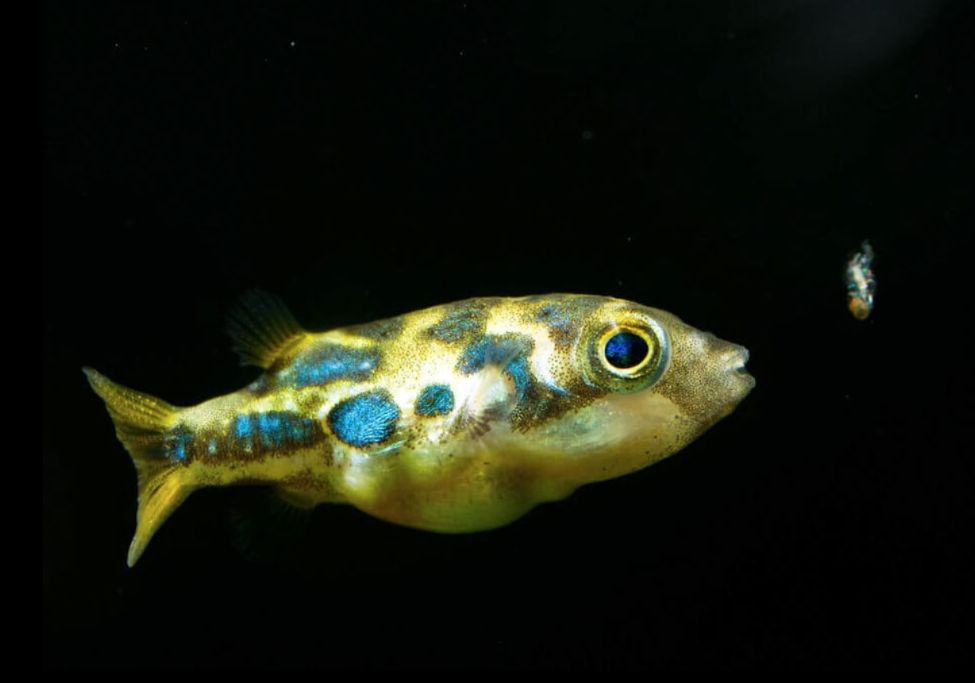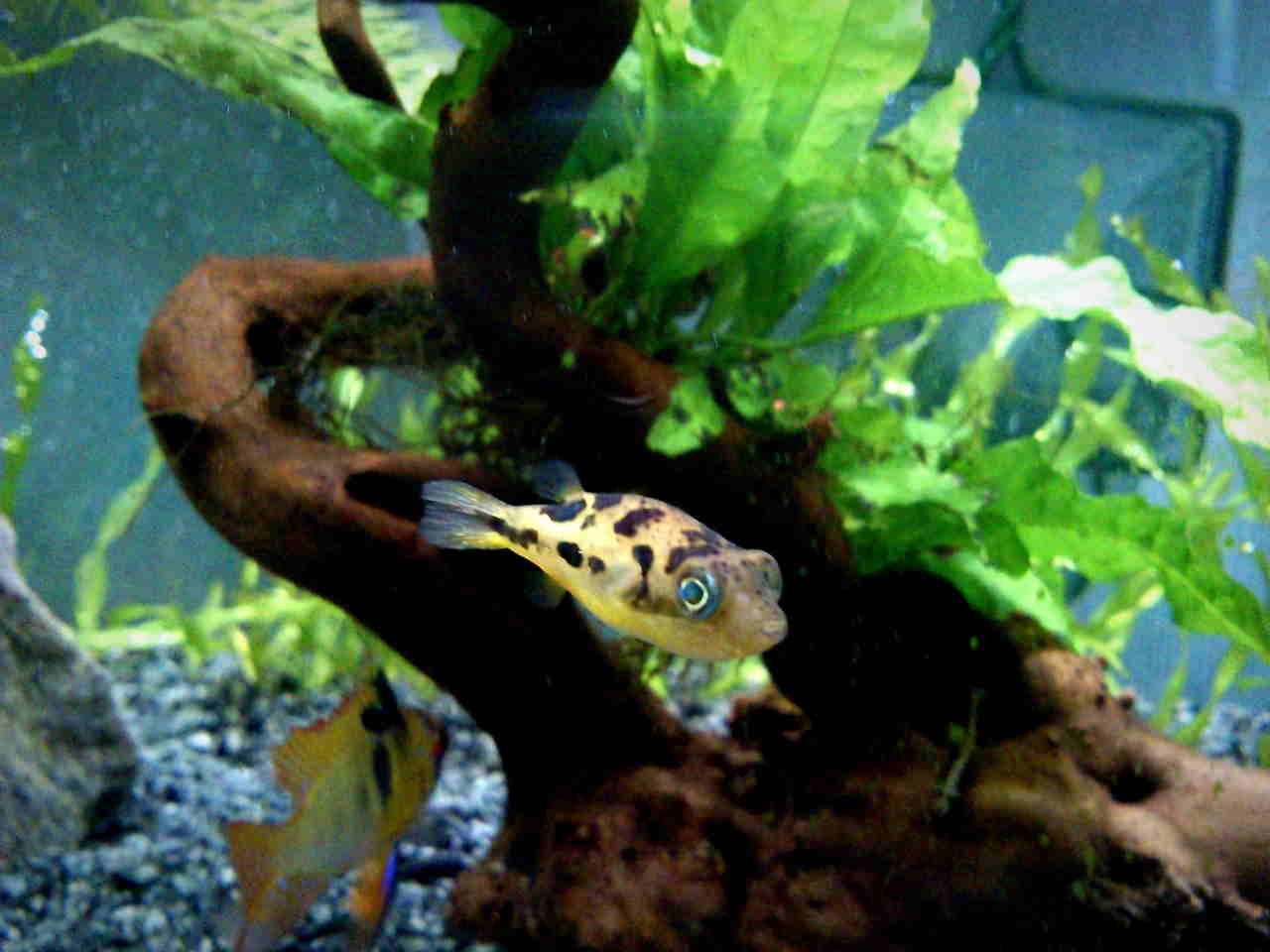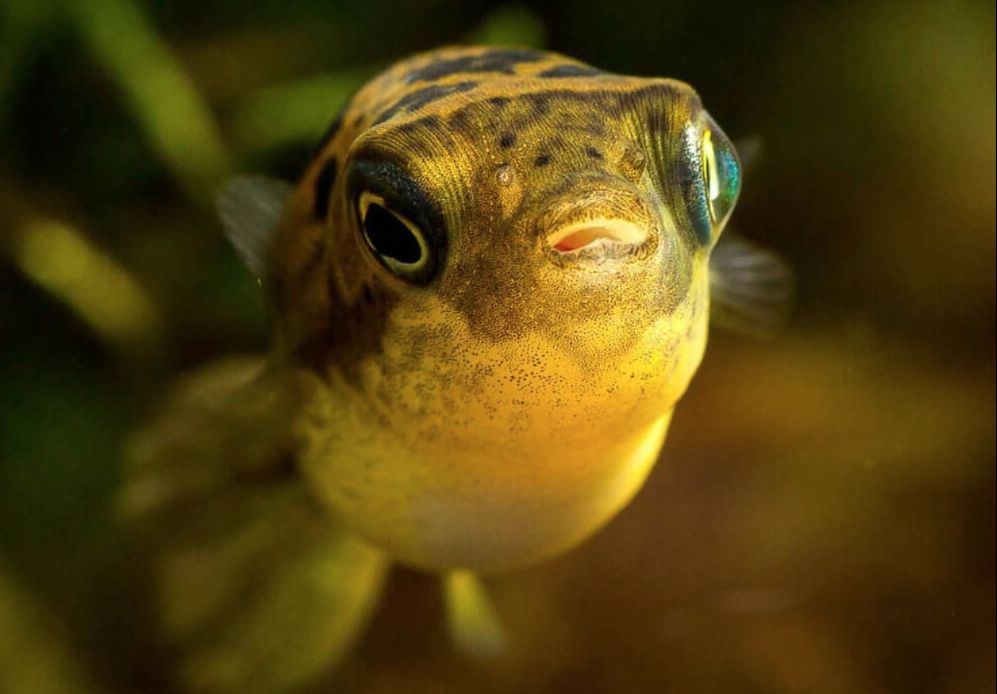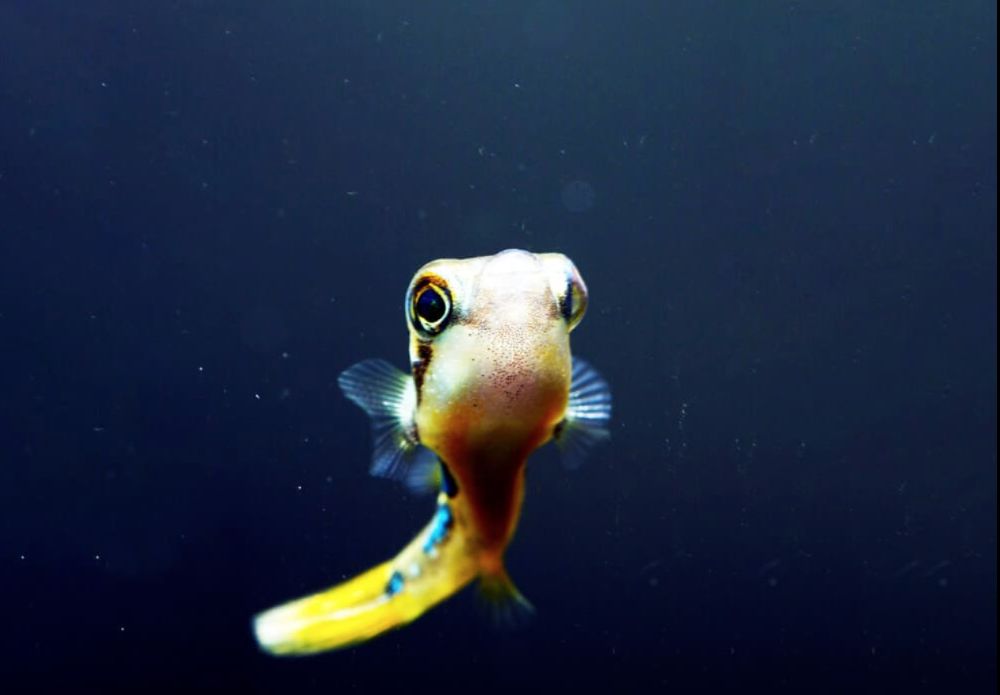The pea puffer (Carinotetraodon travancoricus), commonly known as the dwarf puffer fish or pygmy pufferfish, is a small freshwater fish from the Tetraodontidae family. This species is native to freshwater habitats in India, distinguishing it from other pufferfish that may inhabit marine environments.
Keeping pea puffers requires experience and attention to their specific needs. These fish thrive in well-maintained tanks with stable water conditions. Understanding their habitat, dietary preferences, and social behavior is crucial for successful care. For instance, pea puffers prefer densely planted tanks that mimic their natural environment, providing plenty of hiding spots and foraging opportunities.
With proper care, pea puffers can exhibit fascinating behaviors, making them a rewarding addition to the right aquarium setup.

Contents
Habitat in the wild
Pea puffers (Carinotetraodon travancoricus) are fascinating freshwater fish belonging to the family Tetraodontidae, commonly known as the pufferfish family. This diverse family includes various species of pufferfish, found in both freshwater and marine environments. Notably, while many members of this family can inflate their bodies as a defense mechanism, pea puffers have a limited ability to do so compared to their larger relatives.
Native to Kerala, India, dwarf pufferfish thrive in freshwater habitats, particularly in the Pamba River, which flows into Vembanad Lake. This river features slow-moving waters rich in vegetation, making it an ideal environment for pea puffers. In the wild, they inhabit shallow, plant-filled areas, including rice paddies and flooded fields during the monsoon season.
Pea puffers are closely associated with dense underwater vegetation, such as water hyacinths and water lettuce. These plants provide essential shelter and hunting grounds for small invertebrates, which form a significant part of their diet. Their vibrant colors and active behavior, coupled with intriguing personalities, make them popular among aquarists seeking a lively addition to their tanks.

Description
Body Shape: Pea puffers have a rounded, chubby body shape. When well-fed, they can appear plump and spherical, adding to their endearing qualities.
Coloration: The coloration of pea puffers is particularly striking. They typically display a range of greens, from olive to bright shades, often accented by black or brown patches scattered across their bodies. Their abdomens are usually white or yellowish. This coloration can vary among individuals and may shift in intensity based on their mood or environmental conditions.
Eyes: One of the most charming aspects of pea puffers is their prominent eyes, which are often dark in color. Their expressive eyes move independently, allowing them to observe their surroundings without significant movement, enhancing their playful demeanor.
Beak-like Mouth: A distinctive feature of pea puffers is their beak-like mouth, which is specifically adapted for crushing the shells of snails and other small invertebrates—an essential part of their diet.
Finnage: Pea puffers have relatively short fins. Their dorsal fin, situated on their back, is small and triangular, while the pectoral and pelvic fins are also short. This fin structure complements their unique swimming style, contributing to their overall charm.
Overall, the combination of their captivating appearance and engaging behavior makes pea puffers a delightful addition to any freshwater aquarium.
Size
Pea puffer fish (Carinotetraodon travancoricus) are among the smallest members of the Tetraodontidae family, measuring about 3.5 cm (1.4 in) in length. Commonly known as dwarf pufferfish or pygmy pufferfish, these tiny fish pack a lot of personality into their compact frames, making them fascinating to observe in an aquarium setting
Lifespan
Pea puffers typically have a shorter lifespan compared to many other aquarium fish, living on average for about 3 to 5 years in captivity. However, individual factors such as care, environment, and genetics can influence their longevity.
| Characteristic | Description |
|---|---|
| Common Names | Pea puffer, Dwarf pufferfish, Pygmy pufferfish |
| Scientific Name | Carinotetraodon travancoricus |
| Size | Around 1 inch (2.5 cm) in length |
| Body Shape | Rounded, compact body |
| Coloration | Green, yellow, and brown patches |
| Native Habitat | Freshwater habitats, particularly in India |
| Behavior | Active, curious, and intelligent |
| Tank Size | Minimum of 10 gallons (37 liters) for a small group |
| Tank Setup | Well-maintained aquarium with plants and hiding spots |
| Water Parameters | Clean, well-filtered water; monitor ammonia, nitrite, nitrate, and pH levels |
| Diet | Carnivorous; primarily feeds on small invertebrates like snails, worms, and insects |
| Compatibility | Not suitable for community tanks; can be territorial and aggressive |
| Breeding | Challenging to breed in captivity; separate breeding tank with dense plants may be required |

Care and keeping in a tank
Tank size
While they are small, they still need adequate space to swim and establish territories.
There is some variability in recommendations for tank size. Some sources suggest that a minimum of 2 gallons (about 7.5 liters) per fish might suffice, but a more commonly accepted guideline is at least 10 gallons (37 liters) for a small group of pea puffers. This size allows them to move comfortably and establish their territories. However, if space permits, larger tanks are always better.
A 20-gallon (75 liters) or 30-gallon (113 liters) tank offers even more room for creating a well-structured environment. Such tanks can include additional plants, hiding spots, and open swimming areas, closely mimicking their natural habitat and enhancing their opportunities for exploration and social interactions.
Water parameters
It’s crucial for the tank to be well-balanced and fully established, as dwarf puffer fish are sensitive to ammonia and nitrate levels in the water. While some sources may recommend adding salt to the tank, this is not advisable and can be harmful to pea puffers.
In terms of water parameters, pea puffers are not overly demanding, but it’s essential to avoid extremes. They typically thrive in a pH range of 6.0 to 7.5 and a general hardness (dGH) of 5 to 20. As warm-water fish, they prefer temperatures between 25-26 °C.
To maintain a healthy environment, install a robust filter and perform regular water changes. Keeping nitrate and ammonia levels low is especially important in smaller tanks. However, since pea puffers dislike strong water flow, it’s best to minimize the current to ensure their comfort.
Tank decor
When setting up a tank for pea puffers, the decor plays a crucial role in creating a comfortable and stimulating environment. Here are some suggestions for tank decor that suits their needs:
- Live Plants: Dense vegetation provides hiding spots and reduces stress. Consider using plants like water wisteria, Java fern, or anubias. Floating plants like duckweed can also help diffuse light and create a natural cover.
- Hiding Spots: Incorporate caves and crevices using rocks, driftwood, or commercially available aquarium decorations. Pea puffers appreciate having places to retreat, especially during times of stress or when they’re feeling shy.
- Substrate: A soft substrate, such as sand or fine gravel, is preferable. This helps prevent injury to their delicate bodies and is also suitable for any bottom-dwelling snails or invertebrates you might want to add as a food source.
- Open Swimming Areas: While they love to explore, it’s important to leave open spaces for swimming. Pea puffers are active and enjoy darting around their environment.
- Decorative Items: Use items like hollow logs, rocks, or ceramic pots for additional shelter. Just ensure that any decor you use is aquarium-safe and free of sharp edges.
- Water Flow Management: Since pea puffers don’t like strong currents, you might consider using decorations to break up the flow of water from filters, ensuring a calm swimming environment.
Diet
- Carnivorous Diet: In the wild, pea puffers primarily consume snails, small invertebrates, and insects. This diet helps them maintain their dental health due to their continuously growing teeth.
- Hard-Shelled Foods: Including harder-shelled foods like small snails (e.g., ramshorn snails or Malaysian trumpet snails) is essential, as it helps wear down their teeth and prevents overgrowth.
Recommended Feeding Practices
- Primary Foods:
- Small Snails: Live or frozen snails are excellent staples. They not only provide essential nutrients but also help manage dental health.
- Frozen Foods: Offer frozen options like bloodworms, brine shrimp, or daphnia. These should be used in moderation and serve as supplementary food.
- Variety: To ensure a well-rounded diet, you can rotate different types of frozen or live foods. This diversity helps meet their nutritional requirements and keeps feeding interesting.
- Feeding Frequency: Young pea puffers may need to be fed daily, while adults can be fed every other day. Adjust the feeding schedule based on their appetite and size.
- Avoid Overfeeding: Be mindful of portion sizes. Remove any uneaten food promptly to prevent water quality issues.
Snails
Carinotetraodon travancoricus have a strong instinct to hunt, especially when it comes to snails, which play a crucial role in their diet and dental health. Here’s a closer look at how to incorporate snails into their feeding routine:
- Mental Stimulation: Introducing small pest snails, such as Malaysian trumpet snails (MTS) or ramshorn snails, can provide valuable mental stimulation for pea puffers. Their natural foraging behavior is engaged as they hunt, which can reduce stress and enhance overall well-being.
- Dietary Necessity: Snails are a staple in the wild diet of dwarf puffers. The fish actively seek out these prey items, using their shells to help wear down their continuously growing teeth. Regularly providing snails can mimic their natural feeding habits.
- Size Matters: Pea puffers will focus on smaller snails that they can easily crack. While they may ignore larger snails, they are adept at hunting small ones. Be prepared with a plan for replenishing snails, as they will quickly deplete their supply.
- Hunting Behavior: Pea puffers exhibit unique hunting techniques. They often hover above their target and assess it before striking. This process involves a calculated decision within a specific area of about 5 cm in diameter around the snail. The puffer will wait for the opportune moment to launch its attack, making the hunting experience an engaging spectacle to observe.
- Monitoring and Adjusting: Keep an eye on the snail population in the tank. If they are depleted too quickly, consider adding a breeding setup for snails to ensure a continuous supply without compromising the overall balance of the aquarium.
Tank mates
Bottom-Dwelling Fish: Peaceful bottom-dwelling species like Corydoras catfish or otocinclus catfish can be suitable companions. These fish are typically active and fast enough to avoid aggression from the puffers. They help occupy different areas of the tank, reducing potential conflicts.
Fast-Moving Fish: Small, quick fish that occupy different tank levels may coexist with pea puffers. Species such as zebra danios or small rasboras (like chili rasbora or harlequin rasbora) can work well, but careful monitoring of their interactions is essential. Be ready to separate them if any signs of aggression arise.
Can dwarf puffers live in a community tank?
Pea puffers can exhibit varying behaviors depending on their individual temperaments and tank conditions. While some aquarists have successfully housed them with other fish, others report issues such as nipped fins and stressed tank mates. This inconsistency suggests that a fish’s behavior can be influenced by its environment and the dynamics of the tank.
How many pea puffers should be kept together?
When keeping pea puffers together, it’s essential to balance social interaction with the need to minimize aggression. Known for their territorial nature, these fish can display aggression towards their own species, particularly when they feel their space is threatened or resources are limited.
Group Dynamics
- Small Schools: It’s advisable to keep pea puffers in small groups of 5 to 6 individuals. A well-planted tank with ample hiding spots helps reduce intraspecific aggression, allowing the fish to establish their territories and facilitating easier social interactions.
- Sex Ratio: Maintaining an appropriate sex ratio can further mitigate aggression. Aim for a higher number of females than males. This distribution helps diffuse aggression, preventing any single female from becoming excessively targeted by males.
Tank Environment
- Planted Tank: A densely planted aquarium with numerous hiding spots and visual barriers is crucial. This setup not only allows each pea puffer to establish its territory but also provides escape routes and places to retreat when feeling threatened. Incorporating driftwood, rocks, and caves can enhance the tank’s structure and provide additional shelter.
Conclusion
While pea puffers can technically live alone, they thrive better in groups, which foster natural social behaviors and reduce stress. By creating an enriched environment with sufficient cover and proper social dynamics, you can help ensure a peaceful coexistence among your dwarf puffers.

Gender differences: male vs female
Distinguishing between male and female pea puffers (Carinotetraodon travancoricus) can be quite subtle, as they don’t exhibit prominent physical differences. However, a few characteristics may assist in identifying their gender:
Size
- Females: In some instances, females may appear slightly larger with a rounder belly, especially when carrying eggs. However, this difference is not always pronounced and may not serve as a reliable indicator for sexing.
Behavior
- Courtship Displays: Males often exhibit more vibrant colors and active behaviors during breeding or courtship. They may chase females and perform specific rituals to attract attention. Observing these behaviors can provide clues about the fish’s sex.

Breeding
Pea puffers are known to be challenging to breed in captivity, but they can successfully spawn in a tank setting, albeit not very frequently. Their breeding behavior is influenced by factors such as water conditions, diet, and the availability of suitable partners. Generally, successful breeding is sporadic in home aquariums, and they are not as commonly bred as some other fish species.
When breeding pea puffers, it’s advisable to house a harem of one male with several females. This arrangement helps mitigate the aggressive tendencies of males, who can be quite territorial. A small breeding tank is suitable if you have a couple or a few puffer fish. While light filtration is recommended, regular water changes can sometimes eliminate the need for a filter altogether.
The spawning tank should be densely planted with small-leaved plants like cabomba, Limnophila aquatica, or Java moss, which is particularly favored for egg-laying. Once placed in the spawning tank, feed the fish a diet rich in live food and snails. As the male prepares for spawning, his colors will become more vibrant, and he will begin to court the female by chasing her and gently biting her if she’s not ready. This courtship typically culminates in the moss, where the pair lays eggs.
Pea puffer eggs are small, almost transparent, and non-sticky, measuring about 1 millimeter in diameter. They usually appear round or oval and may look slightly opaque or milky when freshly laid. As they develop, the embryos inside become visible as tiny dark spots. The spawning can occur multiple times, with the female laying around ten eggs each time, and they may spawn daily if multiple females are present. However, care should be taken, as breeding pea puffers might eat their own eggs.
After a few days, the eggs hatch, and the juveniles initially feed from their yolk sacs. They require very small foods like vinegar eels or infusoria at first, transitioning to brine shrimp nauplii and eventually to frozen food and small snails as they grow. It’s important to sort the juveniles to prevent cannibalism, as they can grow rapidly and may reach about 1 centimeter in length within two months.